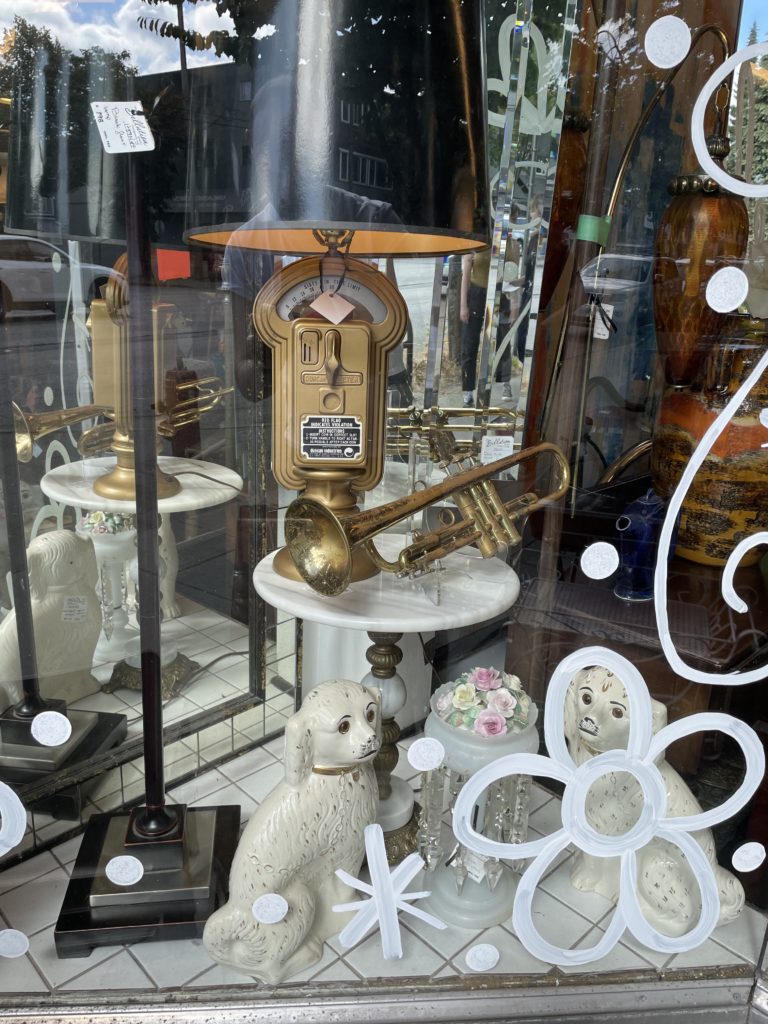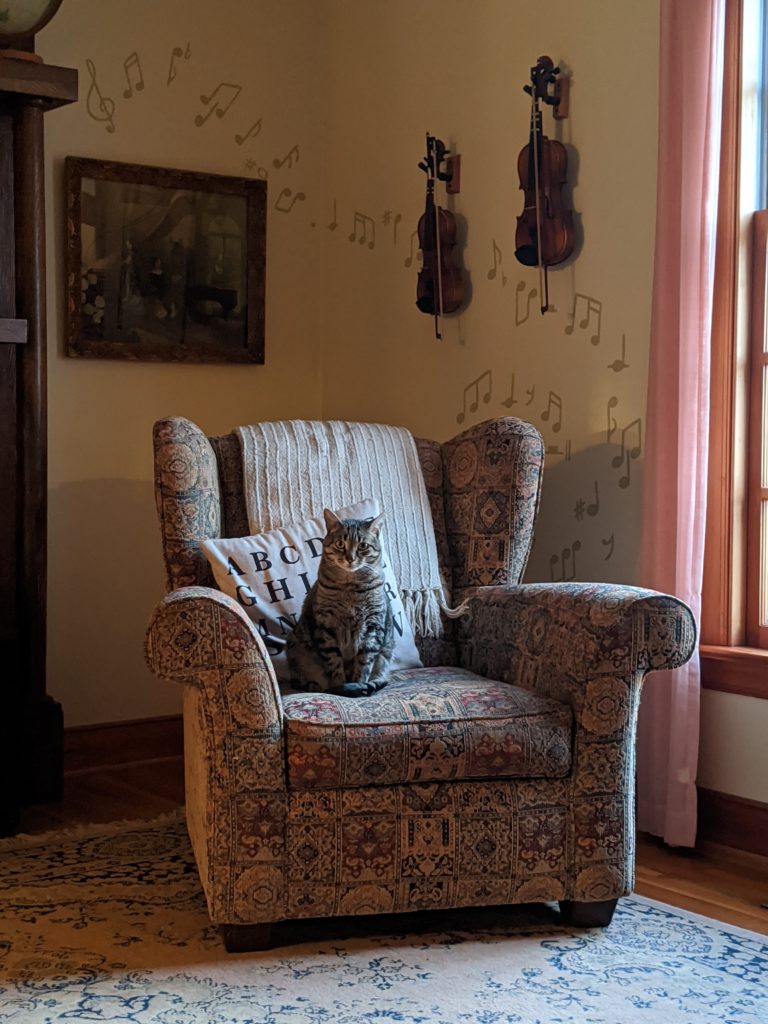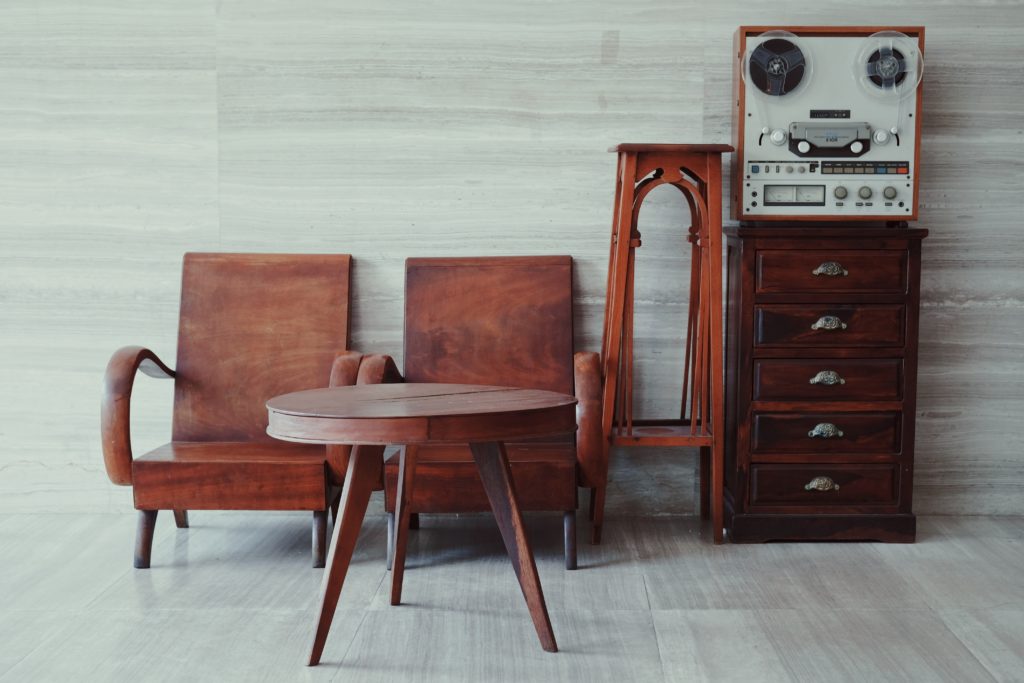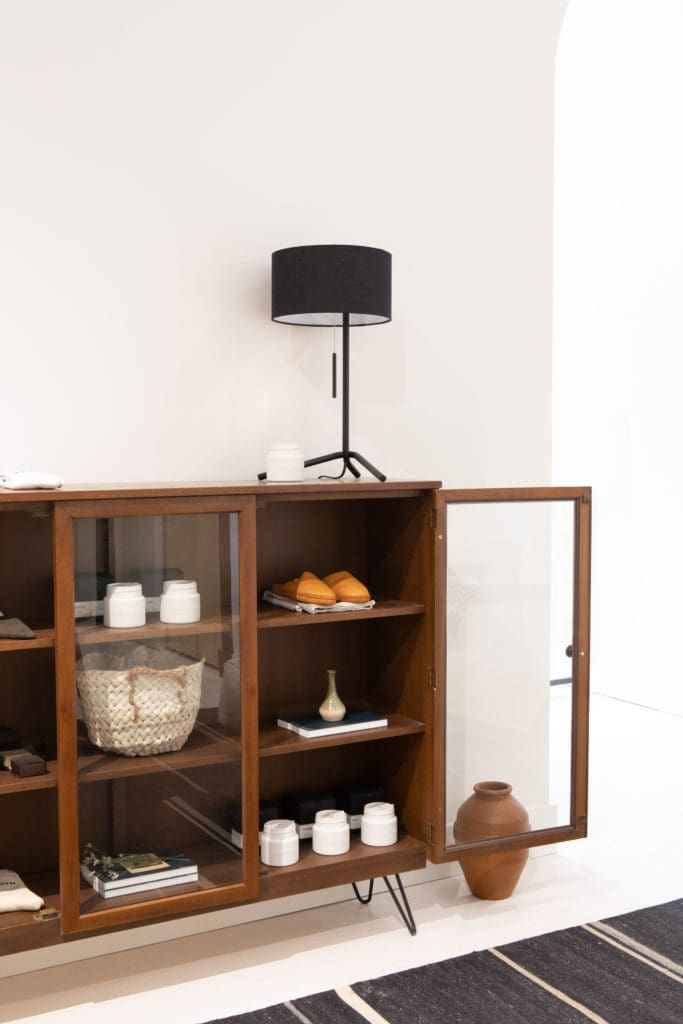Fast food, fast fashion, fast furniture—none of it is good for either people or the planet. And more and more young people are saying “no thanks” to all of it.

“Overall there is a shifting global consumer base that is demanding better of its retail corporations amid the devastating effects of climate change, overconsumption and human rights violations—all of which are especially important to Millennials and Gen Z—and the resale of used goods that already exist in the environment are an answer to that.” That’s according to Kristina Urquhart, founder of Thevintageseeker.ca, an online magazine for buyers and sellers of antiques and vintage items across Canada.
The Toronto resident launched her business in the first year of the pandemic, which she describes as the tipping point for secondhand furniture, with “more people looking to redecorate—and with time on their hands to browse the internet for items—and more people selling to make extra money.” Plus, supply-chain problems (that continue today) meant consumers often faced long wait times when ordering new furniture from overseas, upping the appeal of used items available immediately.
The carbon footprint of constructing new furniture, shipping it and, all too soon, throwing it away, is huge. Many new pieces are so poorly built that they’re not intended to last from one school year to the next, never mind one generation to the next. The Environmental Protection Agency reports that 9.68 million tonnes of furniture and furnishings ended up in landfill in the U.S. in 2018—an increase of more than threefold compared to half a century earlier. But it’s more than just the sustainability aspect that appeals to shoppers today. As the pandemic drags on, many of us are still spending an increased amount of time working, socializing and studying from home. Staring at boring furniture all day just doesn’t cut it anymore.

As a writer, Steffani Cameron is home a lot. “I bought all decent stuff from Ikea and Structube but hated how little personality it had,” she says. After moving from Ottawa to Victoria, she realized that none of the furniture she’d paid to ship across the country worked in her new place. She got rid of it all and replaced it with used pieces that she painted in vibrant colours. “Now all my furniture looks bespoke,” Cameron says. “Amazing what a coat of paint does.” And some of these old pieces have personal stories attached, such as the coffee table made from her great-grandparents’ 120-year-old breadboard.
Rebecca Northan is another fan of how rich in character old furniture is. “I live for secondhand, restored, reupholstered furniture. There is not a lick of new furniture in my house, other than our bed,” says the actor and improviser, who lives in Stratford, Ontario. “Each piece has a story, an adventure, something emotional.”
Secondhand pieces can also be economical. Tanya Johnston, who owns The Sellution in Vancouver, says used furniture is “typically less expensive than what you would spend on a new piece of furniture, and it lasts longer.” She notes, “If you use your imagination, you can do so many things with older furniture to liven it up and make it suit your needs.” As the owner of a consignment store, her problem is having too much of a good thing: Johnston’s staff have been known to stop her from taking home new treasures. “I have so much in my own home that my husband makes me take stuff back,” she says with a laugh.

But used furniture is not always less expensive than buying new, especially when repairs and reupholstering are involved, though the quality is worth the extra cost. “Something that’s moved and moved multiple times over 50, 60, 80 years, other than a few bumps and bruises, they’re solid pieces,” says Diana Ross, owner of A Changing Nest in Toronto.
Nicole McConnell, who runs her vintage furniture and clothing business, @shop.woven, in Vancouver, and has been flipping preloved goods for 15 years, agrees. She says, with a little TLC, “pieces that have been around since the 1950s and ’60s could last another 100 years.” In terms of ensuring you’re purchasing quality items, she gives this advice: “Go with someone who has been doing it for a long time; most local shops are reputable. Ask lots of questions … and check all the drawers!”
McConnell adds that, when it comes to online platforms, not all are created equal. While Facebook Marketplace turns up a plethora of used furniture from private sellers, it’s difficult to vet someone’s reputation—and, thus, the piece they’re posting. Instagram, she offers, is a far safer bet, and it’s “huge for sales of pre-owned furniture these days. There’s an interest in protecting one’s reputation on IG, because sellers are ‘known’ and have their following to answer to. On Marketplace, despite there being a star system that some do use, people can just delete an ad once an item is sold and disappear.”
As for why she believes used décor is trending these days: “I like to think it’s for the planet, but for many people it’s aesthetics, having something unique. But that’s OK, too!”
Indeed, many of these older items have personality. They’re the type of one-of-a-kind pieces that “you’re not seeing in everybody’s living room, and it’s those pieces that people talk about and ask about when they come into your home,” echoes Ross. Whenever customers complain about their own dwellings seeming sterile, like “living in a bad hotel room,” she shares the secret to making a living space feel inviting: “Mix some older pieces in with the new, and that gives you the soul and the feeling. Big difference.”

Pre-owned furniture isn’t just for homes, either. Canadian clothing company Kotn opened a store in Vancouver earlier this year, and 80 per cent of the furniture in it is secondhand. The certified B Corporation has pledged to do the same in each new location. “Sourcing used furniture is a great way to extend the life of old pieces, make use of the resources we already have and support our local communities,” says Mackenzie Yeates, Kotn’s co-founder and chief brand officer. “Part of the joy of finding our best pieces—like our teak table, arch mirror and nesting coffee table stools—was discovering the history behind each of them.”
HGTV star Sarah Richardson also recommends used furniture for homes and businesses. She advises looking past the clutter in any consignment store to sleuth out the tucked-away gems. Gorgeous furniture might be hidden beneath small items, or marred with scratches or a drab colour, but it’s worth the effort to repaint or refinish a well-constructed piece.
Ready to hunt for treasure? Vintage stores, antiques shops, Instagram accounts, Facebook Marketplace and Craigslist are the perfect places to start. All that’s required is a good imagination (and a truck to haul home your finds). —Sheri Radford

January 22nd, 2025 at 2:55 am
pharmacies in mexico that ship to usa: mexico pharmacies prescription drugs – best online pharmacies in mexico
January 24th, 2025 at 10:22 am
http://predpharm.com/# can i purchase prednisone without a prescription
generic prednisone otc
January 24th, 2025 at 6:38 pm
I’ve started using CBD gummies like https://www.cornbreadhemp.com/products/cbd-sleep-gummies , and they’ve made a perceptible disagreement in my routine. They’re submissive to basis, taste monstrous, and provide a simple character to incorporate CBD into my day. I’ve found they help me put one’s feet up and enhance my siesta after a long daytime, which has been a colossal benefit. The agreeing CBD dosage in each gummy is a big benefit for the sake of managing intake. If you’re making allowance for CBD, gummies are an prime choice to start with—honourable draw up sure you select a faithful disgrace payment the best results!
January 24th, 2025 at 9:23 pm
https://cytpharm.com/# Abortion pills online
prednisone 10 mg tablet cost
January 25th, 2025 at 5:27 am
https://predpharm.shop/# prednisone 10mg tablet price
average price of prednisone
January 25th, 2025 at 1:37 pm
https://cytpharm.com/# Cyt Pharm
over the counter prednisone cheap
January 25th, 2025 at 9:30 pm
https://semapharm24.shop/# Sema Pharm 24
prednisone 20mg prices
January 26th, 2025 at 4:50 am
https://kamapharm.com/# Kama Pharm
prednisone 5 mg tablet without a prescription
January 26th, 2025 at 12:11 pm
https://semapharm24.com/# semaglutide tablets
buy prednisone 10mg online
January 26th, 2025 at 7:26 pm
https://kamapharm.shop/# Kama Pharm
prednisone 20mg online pharmacy
January 27th, 2025 at 2:30 am
http://dappharm.com/# buy priligy
prednisone prescription drug
January 27th, 2025 at 8:21 pm
https://cytpharm.shop/# Misoprostol 200 mg buy online
non prescription prednisone 20mg
January 28th, 2025 at 4:27 am
http://farmasilditaly.com/# viagra prezzo farmacia 2023
comprare farmaci online con ricetta
January 30th, 2025 at 8:48 pm
farmacie online autorizzate elenco: farmaci senza ricetta elenco – comprare farmaci online con ricetta
January 31st, 2025 at 7:07 am
Casinos often host special holiday promotions. http://jugabet.xyz/# Los jugadores deben conocer las reglas.
January 31st, 2025 at 10:32 am
Many casinos provide shuttle services for guests.: taya365.art – taya365
January 31st, 2025 at 12:55 pm
phtaya login phtaya Gambling regulations are strictly enforced in casinos.
January 31st, 2025 at 4:42 pm
Live music events often accompany gaming nights. https://taya365.art/# Casinos often host special holiday promotions.
January 31st, 2025 at 9:00 pm
win chile winchile La Г©tica del juego es esencial.
February 1st, 2025 at 5:03 am
phtaya phtaya Some casinos have luxurious spa facilities.
February 1st, 2025 at 11:42 am
Responsible gaming initiatives are promoted actively. https://phtaya.tech/# Many casinos provide shuttle services for guests.
February 1st, 2025 at 1:11 pm
phmacao com phmacao com login Loyalty programs reward regular customers generously.
February 1st, 2025 at 4:34 pm
Casino visits are a popular tourist attraction. https://taya777.icu/# п»їCasinos in the Philippines are highly popular.
February 1st, 2025 at 9:06 pm
The casino scene is constantly evolving.: phmacao – phmacao casino
February 2nd, 2025 at 1:06 pm
Las redes sociales promocionan eventos de casinos.: winchile – winchile casino
February 3rd, 2025 at 5:35 am
Casino promotions draw in new players frequently. http://phtaya.tech/# High rollers receive exclusive treatment and bonuses.
February 3rd, 2025 at 5:35 am
The ambiance is designed to excite players.: taya365 – taya365 com login
February 3rd, 2025 at 4:28 pm
Casinos often host special holiday promotions.: taya365 login – taya365 com login
February 3rd, 2025 at 9:00 pm
http://jugabet.xyz/# Las promociones atraen nuevos jugadores diariamente.
Casino promotions draw in new players frequently.
February 3rd, 2025 at 9:26 pm
Hay casinos en Santiago y ViГ±a del Mar.: jugabet – jugabet casino
February 3rd, 2025 at 11:42 pm
phmacao com phmacao com login The poker community is very active here.
February 4th, 2025 at 11:53 pm
india online pharmacy: Mega India Pharm – MegaIndiaPharm
February 5th, 2025 at 6:09 am
online pharmacy delivery usa: family pharmacy – online pharmacy delivery usa
February 5th, 2025 at 12:23 pm
buy medicines online in india: Mega India Pharm – online shopping pharmacy india
February 5th, 2025 at 6:37 pm
xxl mexican pharm: buying prescription drugs in mexico – xxl mexican pharm
February 5th, 2025 at 7:45 pm
online pharmacy no prescription https://xxlmexicanpharm.shop/# xxl mexican pharm
February 6th, 2025 at 12:54 am
easy canadian pharm: canadian pharmacies that deliver to the us – my canadian pharmacy review
February 6th, 2025 at 4:10 am
buying prescription drugs in mexico online xxl mexican pharm xxl mexican pharm
February 6th, 2025 at 7:24 am
MegaIndiaPharm: MegaIndiaPharm – MegaIndiaPharm
February 6th, 2025 at 1:48 pm
canadianpharmacyworld: canadian online drugs – buy drugs from canada
February 6th, 2025 at 1:58 pm
canadian pharmacy no prescription needed https://xxlmexicanpharm.com/# xxl mexican pharm
February 6th, 2025 at 7:38 pm
online pharmacy non prescription drugs http://easycanadianpharm.com/# vipps approved canadian online pharmacy
February 7th, 2025 at 1:16 am
canadian pharmacy discount code http://xxlmexicanpharm.com/# buying prescription drugs in mexico
February 7th, 2025 at 7:47 am
easy canadian pharm: legit canadian pharmacy – easy canadian pharm
February 7th, 2025 at 12:21 pm
mexican online pharmacies prescription drugs xxl mexican pharm pharmacies in mexico that ship to usa
February 7th, 2025 at 12:52 pm
foreign pharmacy no prescription http://easycanadianpharm.com/# trusted canadian pharmacy
February 7th, 2025 at 2:04 pm
MegaIndiaPharm: Mega India Pharm – india online pharmacy
February 7th, 2025 at 8:07 pm
canadian pharmacy ratings: legitimate canadian pharmacy – canadian mail order pharmacy
February 7th, 2025 at 11:11 pm
easy canadian pharm canadian 24 hour pharmacy cheap canadian pharmacy online
February 8th, 2025 at 2:11 am
discount drugs: discount drug mart – drugmart
February 8th, 2025 at 7:44 pm
rxpharmacycoupons https://discountdrugmart.pro/# discount drug mart pharmacy
February 9th, 2025 at 6:08 am
Slot menawarkan berbagai jenis permainan bonus http://bonaslot.site/# Slot menjadi daya tarik utama di kasino
February 9th, 2025 at 11:01 am
Slot memberikan kesempatan untuk menang besar http://bonaslot.site/# Slot modern memiliki grafik yang mengesankan
February 9th, 2025 at 1:54 pm
preman69 slot preman69.tech Permainan slot mudah dipahami dan menyenangkan
February 9th, 2025 at 9:19 pm
Slot dengan grafis 3D sangat mengesankan https://bonaslot.site/# Kasino selalu memperbarui mesin slotnya
February 9th, 2025 at 10:00 pm
Mesin slot dapat dimainkan dalam berbagai bahasa: slot demo rupiah – slot demo pg gratis
February 10th, 2025 at 3:38 am
Banyak kasino memiliki promosi untuk slot: preman69 – preman69.tech
February 10th, 2025 at 9:32 am
Slot dengan bonus putaran gratis sangat populer: bonaslot.site – bonaslot.site
February 10th, 2025 at 9:11 pm
https://slotdemo.auction/# Slot menjadi bagian penting dari industri kasino
February 12th, 2025 at 4:08 am
Kasino menawarkan pengalaman bermain yang seru http://preman69.tech/# Mesin slot dapat dimainkan dalam berbagai bahasa
February 12th, 2025 at 5:06 am
Banyak pemain berusaha untuk mendapatkan jackpot: garuda888 – garuda888.top
February 13th, 2025 at 1:02 am
Permainan slot mudah dipahami dan menyenangkan: garuda888.top – garuda888 slot
February 13th, 2025 at 6:54 am
Permainan slot mudah dipahami dan menyenangkan http://garuda888.top/# Banyak kasino menawarkan permainan langsung yang seru
February 13th, 2025 at 7:02 am
Slot klasik tetap menjadi favorit banyak orang: BonaSlot – bonaslot.site
February 13th, 2025 at 6:23 pm
amoxicillin 500 mg: Amo Health Pharm – amoxicillin 500 mg
February 13th, 2025 at 8:01 pm
can i purchase cheap clomid prices can i purchase generic clomid pills can you get clomid now
February 13th, 2025 at 10:56 pm
can i purchase cheap clomid no prescription: cost generic clomid pills – order cheap clomid no prescription
February 14th, 2025 at 12:04 am
can i buy amoxicillin over the counter in australia: AmoHealthPharm – amoxicillin 500mg without prescription
February 14th, 2025 at 5:15 am
where can you buy doxycycline online: doxycycline where to get – cheap doxycycline 100mg capsule
February 14th, 2025 at 11:50 am
zithromax coupon: zithromax 500 without prescription – buy zithromax no prescription
February 14th, 2025 at 6:06 pm
cost of doxycycline in canada: buy doxycycline 11554 – doxycycline 50
February 15th, 2025 at 12:21 am
can you purchase amoxicillin online: AmoHealthPharm – amoxicillin over the counter in canada
February 15th, 2025 at 12:23 am
doxycycline order online uk: doxycycline 25mg – can i buy doxycycline online
February 15th, 2025 at 6:23 am
doxycycline generic brand: doxycycline order online – buy doxycycline without rx
February 15th, 2025 at 6:40 am
amoxicillin online canada: amoxicillin 500mg capsule – amoxicillin discount coupon
February 15th, 2025 at 12:31 pm
doxycycline australia: how much is doxycycline in south africa – buy doxycycline online no prescription
February 15th, 2025 at 1:07 pm
buy cheap clomid no prescription: how can i get clomid without a prescription – order clomid price
February 15th, 2025 at 6:41 pm
doxycycline pills online: Dox Health Pharm – doxycycline online purchase
February 15th, 2025 at 7:36 pm
doxycycline pills price in south africa: Dox Health Pharm – doxycycline 50 mg
February 16th, 2025 at 12:57 am
zithromax over the counter uk: zithromax antibiotic – zithromax prescription
February 16th, 2025 at 2:05 am
zithromax purchase online: zithromax 1000 mg pills – generic zithromax india
February 16th, 2025 at 8:20 am
Viagra homme prix en pharmacie: acheter du viagra – Viagra homme sans prescription
February 16th, 2025 at 12:17 pm
pharmacie en ligne sans ordonnance kamagra gel Pharmacie en ligne livraison Europe
February 16th, 2025 at 1:07 pm
pharmacie en ligne livraison europe: kamagra pas cher – pharmacie en ligne fiable
February 16th, 2025 at 7:20 pm
pharmacie en ligne sans ordonnance: Pharmacies en ligne certifiees – pharmacie en ligne
February 16th, 2025 at 8:55 pm
http://pharmaciemeilleurprix.com/# pharmacie en ligne avec ordonnance
Achat mГ©dicament en ligne fiable
February 16th, 2025 at 11:16 pm
pharmacies en ligne certifiГ©es: pharmacie en ligne sans ordonnance – pharmacie en ligne livraison europe
February 17th, 2025 at 3:01 am
https://pharmaciemeilleurprix.com/# Achat mГ©dicament en ligne fiable
pharmacie en ligne pas cher
February 17th, 2025 at 5:03 am
SildГ©nafil 100 mg sans ordonnance: Acheter Viagra Cialis sans ordonnance – Sildenafil teva 100 mg sans ordonnance
February 17th, 2025 at 9:10 am
https://viagrameilleurprix.com/# Viagra pas cher livraison rapide france
vente de mГ©dicament en ligne
February 17th, 2025 at 11:03 am
Viagra vente libre pays: Viagra sans ordonnance 24h – Acheter Sildenafil 100mg sans ordonnance
February 17th, 2025 at 3:29 pm
http://pharmaciemeilleurprix.com/# trouver un mГ©dicament en pharmacie
trouver un mГ©dicament en pharmacie
February 17th, 2025 at 5:30 pm
pharmacie en ligne sans ordonnance pharmacie en ligne pas cher vente de mГ©dicament en ligne
February 17th, 2025 at 9:40 pm
https://tadalafilmeilleurprix.com/# pharmacie en ligne
pharmacie en ligne fiable
February 18th, 2025 at 3:54 am
http://kamagrameilleurprix.com/# pharmacie en ligne fiable
pharmacie en ligne
February 18th, 2025 at 5:08 am
pharmacie en ligne france livraison belgique: Cialis sans ordonnance 24h – п»їpharmacie en ligne france
February 18th, 2025 at 11:14 am
pharmacie en ligne avec ordonnance: Acheter Cialis – acheter mГ©dicament en ligne sans ordonnance
February 18th, 2025 at 5:19 pm
vente de mГ©dicament en ligne: achat kamagra – pharmacie en ligne france fiable
February 18th, 2025 at 10:47 pm
https://tadalafilmeilleurprix.shop/# pharmacie en ligne fiable
Pharmacie en ligne livraison Europe
February 18th, 2025 at 11:22 pm
Viagra pas cher paris: viagra sans ordonnance – Viagra gГ©nГ©rique sans ordonnance en pharmacie
February 19th, 2025 at 12:29 am
vente de mГ©dicament en ligne https://viagrameilleurprix.com/# Viagra pas cher paris
February 19th, 2025 at 6:08 am
pharmacies en ligne certifiГ©es: kamagra gel – pharmacie en ligne sans ordonnance
February 19th, 2025 at 1:12 pm
http://tadalafilmeilleurprix.com/# pharmacie en ligne pas cher
pharmacie en ligne avec ordonnance
February 19th, 2025 at 1:53 pm
pharmacie en ligne fiable achat kamagra acheter mГ©dicament en ligne sans ordonnance
February 20th, 2025 at 4:43 am
https://kamagrameilleurprix.com/# Pharmacie en ligne livraison Europe
pharmacie en ligne
February 20th, 2025 at 4:47 am
acheter mГ©dicament en ligne sans ordonnance: acheter kamagra site fiable – pharmacies en ligne certifiГ©es
February 20th, 2025 at 1:07 pm
https://pharmaciemeilleurprix.shop/# pharmacie en ligne france pas cher
pharmacie en ligne pas cher
February 20th, 2025 at 1:34 pm
pharmacie en ligne fiable: Pharmacies en ligne certifiees – Achat mГ©dicament en ligne fiable
February 20th, 2025 at 1:48 pm
Achat mГ©dicament en ligne fiable: Acheter Cialis – pharmacie en ligne france livraison belgique
February 20th, 2025 at 7:38 pm
https://viagrameilleurprix.shop/# Viagra femme ou trouver
п»їpharmacie en ligne france
February 20th, 2025 at 10:34 pm
pharmacie en ligne livraison europe: acheter mГ©dicament en ligne sans ordonnance – pharmacie en ligne livraison europe
February 21st, 2025 at 2:44 am
https://tadalafilmeilleurprix.com/# pharmacie en ligne pas cher
vente de mГ©dicament en ligne
February 21st, 2025 at 8:45 am
SildГ©nafil 100 mg sans ordonnance: Acheter Viagra Cialis sans ordonnance – Meilleur Viagra sans ordonnance 24h
February 21st, 2025 at 10:22 am
http://viagrameilleurprix.com/# Viagra sans ordonnance livraison 48h
pharmacie en ligne france livraison internationale
February 21st, 2025 at 5:40 pm
acheter mГ©dicament en ligne sans ordonnance: pharmacie en ligne france – trouver un mГ©dicament en pharmacie
February 21st, 2025 at 5:43 pm
https://pharmaciemeilleurprix.shop/# acheter mГ©dicament en ligne sans ordonnance
pharmacie en ligne livraison europe
February 21st, 2025 at 11:49 pm
https://pharmaciemeilleurprix.com/# acheter mГ©dicament en ligne sans ordonnance
acheter mГ©dicament en ligne sans ordonnance
February 22nd, 2025 at 5:35 am
http://pharmaciemeilleurprix.com/# Pharmacie en ligne livraison Europe
pharmacie en ligne france fiable
February 22nd, 2025 at 6:22 pm
https://kamagrameilleurprix.com/# Pharmacie sans ordonnance
pharmacie en ligne avec ordonnance
February 23rd, 2025 at 2:31 am
Sildenafil teva 100 mg sans ordonnance: viagra sans ordonnance – Viagra homme prix en pharmacie sans ordonnance
February 23rd, 2025 at 6:35 am
http://kamagrameilleurprix.com/# п»їpharmacie en ligne france
Pharmacie sans ordonnance
February 23rd, 2025 at 2:42 pm
https://pharmaciemeilleurprix.shop/# pharmacie en ligne france livraison belgique
pharmacie en ligne livraison europe
February 23rd, 2025 at 4:13 pm
vente de mГ©dicament en ligne: pharmacie en ligne france – pharmacies en ligne certifiГ©es
February 24th, 2025 at 5:00 am
https://kamagrameilleurprix.shop/# acheter mГ©dicament en ligne sans ordonnance
pharmacie en ligne france livraison internationale
February 24th, 2025 at 6:10 am
Achat mГ©dicament en ligne fiable: cialis sans ordonnance – pharmacie en ligne france fiable